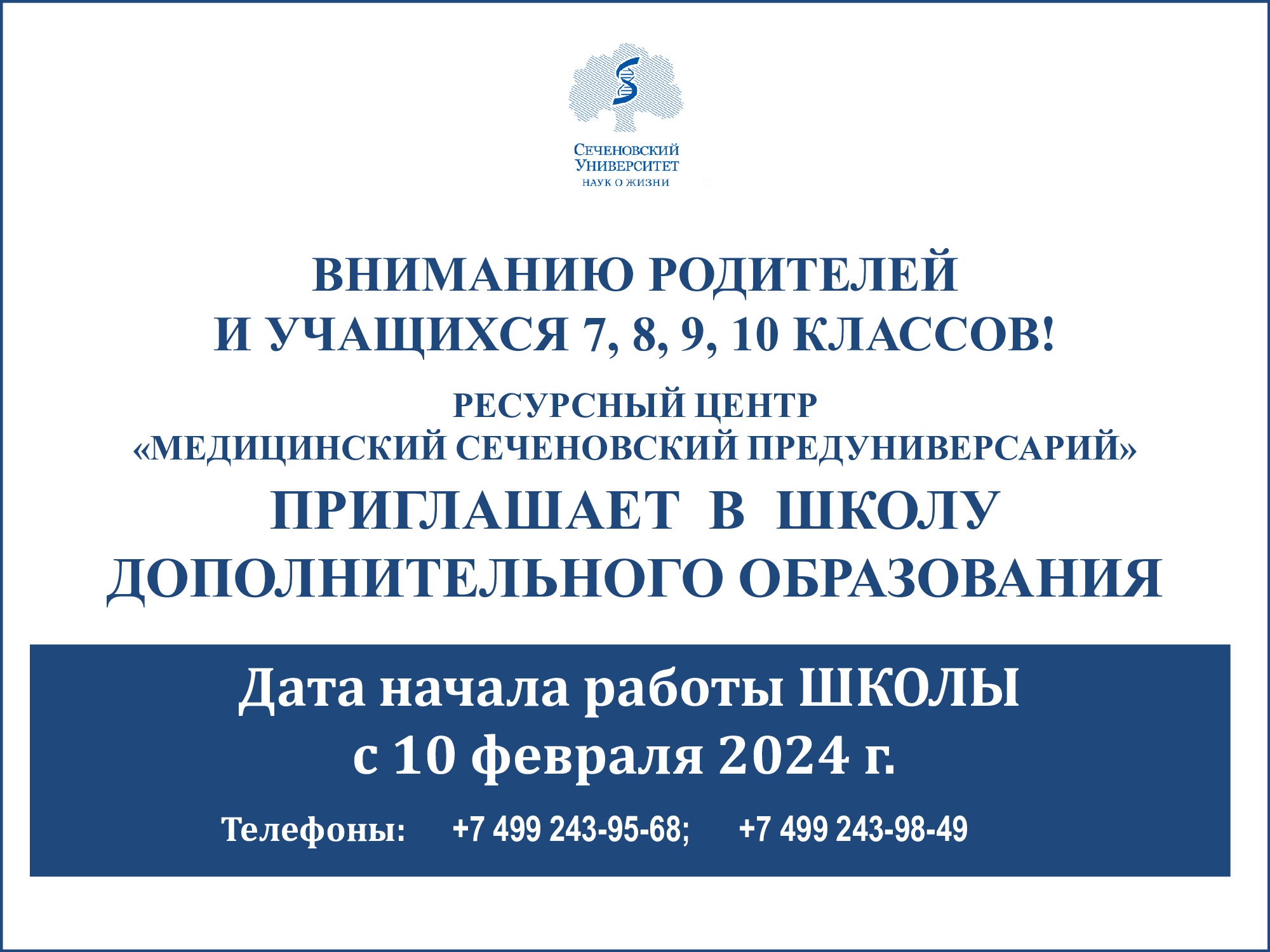|
Is there enough evidence to discontinue the renin-angiotensin system inhibitors in patients with COVID-19?
|
01.10.2020 |
Bobkova I.
Kamyshova E.
Rudenko T.
Stavrovskaya E.
Moiseev S.
|
Medical Hypotheses |
10.1016/j.mehy.2020.109888 |
0 |
Ссылка
|
|
Transcription-facilitating histone chaperons interact with genomic and synthetic G4 structures
|
01.10.2020 |
Pavlova I.I.
Tsvetkov V.B.
Isaakova E.A.
Severov V.V.
Khomyakova E.A.
Lacis I.A.
Lazarev V.N.
Lagarkova M.A.
Pozmogova G.E.
Varizhuk A.M.
|
International Journal of Biological Macromolecules |
10.1016/j.ijbiomac.2020.05.173 |
0 |
Ссылка
© 2020 Elsevier B.V. Affinity for G-quadruplex (G4) structures may be a common feature of transcription-facilitating histone chaperons (HCs). This assumption is based on previous unmatched studies of HCs FACT, nucleolin (NCL), BRD3, and ATRX. We verified this assumption and considered its implications for the therapeutic applications of synthetic (exogenous) G4s and the biological significance of genomic G4s. First, we questioned whether exogenous G4s that recognize cell-surface NCL and could trap other HCs in the nucleus are usable as anticancer agents. We performed in vitro binding assays and selected leading multi-targeted G4s. They exhibited minor effects on cell viability. The presumed NCL-regulated intracellular transport of G4s was inefficient or insufficient for tumor-specific G4 delivery. Next, to clarify whether G4s in the human genome could recruit HCs, we compared available HC ChIP-seq data with G4-seq/G4-ChIP-seq data. Several G4s, including the well-known c-Myc quadruplex structure, were found to be colocalized with HC occupancy sites in cancer cell lines. As evidenced by our molecular modeling data, c-Myc G4 might interfere with the HC function of BRD3 but is unlikely to prevent the BRD3-driven assembly of the chromatin remodeling complex. The c-Myc case illustrates the intricate role of genomic G4s in chromatin remodeling, nucleosome remodeling, and transcription.
Читать
тезис
|
|
Epithelial-to-mesenchymal transition as the driver of changing carcinoma and glioblastoma microenvironment
|
01.10.2020 |
Majc B.
Sever T.
Zarić M.
Breznik B.
Turk B.
Lah T.T.
|
Biochimica et Biophysica Acta - Molecular Cell Research |
10.1016/j.bbamcr.2020.118782 |
0 |
Ссылка
© 2020 Epithelial-to-mesenchymal transition (EMT) is an essential molecular and cellular process that is part of normal embryogenesis and wound healing, and also has a ubiquitous role in various types of carcinoma and glioblastoma. EMT is activated and regulated by specific microenvironmental endogenous triggers and a complex network of signalling pathways. These mostly include epigenetic events that affect protein translation-controlling factors and proteases, altogether orchestrated by the switching on and off of oncogenes and tumour-suppressor genes in cancer cells. The hallmark of cancer-linked EMT is that the process is incomplete, as it is opposed by the reverse process of mesenchymal-to-epithelial transition, which results in a hybrid epithelial/mesenchymal phenotype that shows notable cell plasticity. This is a characteristic of cancer stem cells (CSCs), and it is of the utmost importance in their niche microenvironment, where it governs CSC migratory and invasive properties, thereby creating metastatic CSCs. These cells have high resistance to therapeutic treatments, in particular in glioblastoma.
Читать
тезис
|
|
Controlling anisotropic electrical conductivity in porous graphene-nanotube thin films
|
15.09.2020 |
Slepchenkov M.M.
Shmygin D.S.
Zhang G.
Glukhova O.E.
|
Carbon |
10.1016/j.carbon.2020.04.069 |
0 |
Ссылка
© 2020 Elsevier Ltd We suggest an idea of a new method for controlling the electrical conductivity of graphene-nanotube films using the physical effect that arises from the seamless contact of vertically oriented single-walled carbon nanotubes (SWCNTs) with graphene layers. When increasing the nanotube length by atomic layers in a graphene nanohole, the electrical conductivity of the graphene layer oscillates. This effect is based on the natural feature of armchair nanotubes, whose electronic properties and energy critically depend on the atomic framework length. The results of in silico studies show that the appearance of this effect leads to an increase in the electrical conductivity of graphene layers by 3–10 times. Besides, there is anisotropy: the electrical conductivity is 3–7 times greater in the armchair direction than in the zigzag direction. By adjusting the nanotube length, one can control the magnitude of the electrical conductivity and anisotropy. The amplitude of the oscillations is determined by the nanotube diameter, the symmetry of the transition zone of the seamless contact between graphene and nanotube, and the distance between nanotubes. To conduct in silico studies, an original approach is developed to identify energetically favorable SWCNT-graphene junctions during the formation of SWCNT of various diameters in a graphene nanohole.
Читать
тезис
|
|
Controlling anisotropic electrical conductivity in porous graphene-nanotube thin films
|
15.09.2020 |
Slepchenkov M.M.
Shmygin D.S.
Zhang G.
Glukhova O.E.
|
Carbon |
10.1016/j.carbon.2020.04.069 |
0 |
Ссылка
© 2020 Elsevier Ltd We suggest an idea of a new method for controlling the electrical conductivity of graphene-nanotube films using the physical effect that arises from the seamless contact of vertically oriented single-walled carbon nanotubes (SWCNTs) with graphene layers. When increasing the nanotube length by atomic layers in a graphene nanohole, the electrical conductivity of the graphene layer oscillates. This effect is based on the natural feature of armchair nanotubes, whose electronic properties and energy critically depend on the atomic framework length. The results of in silico studies show that the appearance of this effect leads to an increase in the electrical conductivity of graphene layers by 3–10 times. Besides, there is anisotropy: the electrical conductivity is 3–7 times greater in the armchair direction than in the zigzag direction. By adjusting the nanotube length, one can control the magnitude of the electrical conductivity and anisotropy. The amplitude of the oscillations is determined by the nanotube diameter, the symmetry of the transition zone of the seamless contact between graphene and nanotube, and the distance between nanotubes. To conduct in silico studies, an original approach is developed to identify energetically favorable SWCNT-graphene junctions during the formation of SWCNT of various diameters in a graphene nanohole.
Читать
тезис
|
|
Anatomical and radiological features of the bone organization of the anterior part of the mandible
|
01.09.2020 |
Vasil'ev Y.
Paulsen F.
Dydykin S.
|
Annals of Anatomy |
10.1016/j.aanat.2020.151512 |
0 |
Ссылка
© 2020 Elsevier GmbH Background: The classical anatomical representation of the lingual relief of the mental region of the mandible reflects the presence of geniohyoid as well as genioglossus attachment areas, which are divided into two or single areas. The International Anatomical Terminology (contains references to the presence of upper and lower spinae mentales, but the terminology does not reflect the content of these structures. The aim of this study was to examine and classify the lingual canals of the mental region. Materials and methods: Using a Sirona ORTHOPHOS XG 3D tomograph (isotropic voxel size 0.1 in high-resolution mode) and KaVo 3D eXam cone beam computed tomography, the mental region of the mandible was analyzed in 561 patients aged 18–75 years with regard to bone density and the occurrence of a canal opening on the lingual side of the mandible. In order to visualize the mental spine area, another 50 mandibles were analyzed, divided into two groups of 25 mandibels each: 25 native and 25 dry preparations. Results: By prevalence the following channel types were classified: in 33% type I (narrow); in 32% type II (double) and of these in 17.5% (convergent) and type IIb in 14.5% a type IIb subtype (non-convergent); in 14% type III (wide); in 12% type IV (hook-shaped) and in 9% type V (diverging channel), identifying three combined components: the system of channels of the superior and inferior mental spine, and the transversal intraosseous canal of the mental region of the mandible. Conclusions: Our anatomical and radiological approach allowed us to suggest a new classification of intraosseous organization of the anterior part of the human mandible. As a result of studying X-ray anatomical and anatomical-topographical, constitutional-based, structural features of the mandible, intraosseous structures of the anterior mandible were clarified and classified, which solve not only terminological disputes, but also are important clinical guidelines for bone surgery, prosthetics, traumatology, endodontic treatment, dental implantation and local anesthesia.
Читать
тезис
|
|
Impact of robotic learning curve on histopathology in rectal cancer: A pooled analysis
|
01.09.2020 |
Gachabayov M.
Kim S.H.
Jimenez-Rodriguez R.
Kuo L.J.
Cianchi F.
Tulina I.
Tsarkov P.
Bergamaschi R.
|
Surgical Oncology |
10.1016/j.suronc.2020.04.011 |
0 |
Ссылка
© 2020 Elsevier Ltd Background: A beneficial impact of robotic proctectomy on circumferential resection margin (CRM) is expected due to the robot's articulating instruments in the pelvis. There are however concerns about a negative impact on the quality of total mesorectal excision (TME) due to the lack of tactile feedback. The aim of this study was to assess whether surgeons' learning curve impacted CRM and TME quality. Methods: In a multicenter study, individual patient data of robotic proctectomy for resectable rectal cancer were pooled. Patients were stratified into two phases of surgeons’ learning curve. Cumulative sum (CUSUM) analysis was used to determine the transition from learning phase (LP) to plateau phase (PP), which were compared. CRM was microscopically measured in mm by pathologists. TME quality was classified by pathologists as complete, nearly complete or incomplete. T-test and Chi-squared tests were used to compare continuous and categorical variables, respectively. Results: 235 patients underwent robotic proctectomy by five surgeons. 83 LP patients were comparable to 152 PP patients for age (p = 0.20), gender (67.5% vs. 65.1% males; p = 0.72), BMI (p = 0.82), cancer stage (p = 0.36), neoadjuvant chemoradiation (p = 0.13), distance of tumor from anal verge (5.8 ± 4.4 vs. 5.5 ± 3.3; p = 0.56). CRM did not differ (7.7 ± 11.4 mm vs. 8.4 ± 10.3 mm; p = 0.62). The rate of complete TME quality was significantly improved in PP patients as compared to LP patients (73.5% vs. 92.1%; p < 0.001). Conclusion: While learning had no impact on circumferential resection margins, the quality of TME significantly improved during surgeons’ plateau phase as compared to their learning phase.
Читать
тезис
|
|
Poly(3-hydroxybutyrate)/hydroxyapatite/alginate scaffolds seeded with mesenchymal stem cells enhance the regeneration of critical-sized bone defect
|
01.09.2020 |
Volkov A.V.
Muraev A.A.
Zharkova I.I.
Voinova V.V.
Akoulina E.A.
Zhuikov V.A.
Khaydapova D.D.
Chesnokova D.V.
Menshikh K.A.
Dudun A.A.
Makhina T.K.
Bonartseva G.A.
Asfarov T.F.
Stamboliev I.A.
Gazhva Y.V.
Ryabova V.M.
Zlatev L.H.
Ivanov S.Y.
Shaitan K.V.
Bonartsev A.P.
|
Materials Science and Engineering C |
10.1016/j.msec.2020.110991 |
0 |
Ссылка
© 2020 Elsevier B.V. A critical-sized calvarial defect in rats is employed to reveal the osteoinductive properties of biomaterials. In this study, we investigate the osteogenic efficiency of hybrid scaffolds based on composites of a biodegradable and biocompatible polymer, poly(3-hydroxybutyrate) (PHB) with hydroxyapatite (HA) filled with alginate (ALG) hydrogel containing mesenchymal stem cells (MSCs) on the regeneration of the critical-sized radial defect of the parietal bone in rats. The scaffolds based on PHB and PHB/HA with desired shapes were prepared by two-stage salt leaching technique using a mold obtained by three-dimensional printing. To obtain PHB/HA/ALG/MSC scaffolds seeded with MSCs, the scaffolds were filled with ALG hydrogel containing MSCs; acellular PHB/ALG and PHB/ALG filled with empty ALG hydrogel were prepared for comparison. The produced scaffolds have high porosity and irregular interconnected pore structure. PHB/HA scaffolds supported MSC growth and induced cell osteogenic differentiation in a regular medium in vitro that was manifested by an increase in ALP activity and expression of the CD45 phenotype marker. The data of computed tomography and histological studies showed 94% and 92%, respectively, regeneration of critical-sized calvarial bone defect in vivo at 28th day after implantation of MSC-seeded PHB/HA/ALG/MSC scaffolds with 3.6 times higher formation of the main amount of bone tissue at 22–28 days in comparison with acellular PHB/HA/ALG scaffolds that was shown at the first time by fluorescent microscopy using the original technique of intraperitoneal administration of fluorescent dyes to living postoperative rats. The obtained in vivo results can be associated with the MSC-friendly microstructure and in vitro osteogenic properties of PHB/HA base-scaffolds. Thus, the obtained data demonstrate the potential of MSCs encapsulated in the bioactive biopolymer/mineral/hydrogel scaffold to improve the bone regeneration process in critical-sized bone defects.
Читать
тезис
|
|
Hair trace element concentrations in autism spectrum disorder (ASD) and attention deficit/hyperactivity disorder (ADHD)
|
01.09.2020 |
Skalny A.V.
Mazaletskaya A.L.
Ajsuvakova O.P.
Bjørklund G.
Skalnaya M.G.
Notova S.V.
Chernova L.N.
Skalny A.A.
Burtseva T.I.
Tinkov A.A.
|
Journal of Trace Elements in Medicine and Biology |
10.1016/j.jtemb.2020.126539 |
0 |
Ссылка
© 2020 Elsevier GmbH Background: The existing data demonstrate that alteration of trace element and mineral status in children with neurodevelopmental disorders including ASD and ADHD. However, comparative analysis of the specific patterns of trace element and mineral metabolism in children with ASD and ADHD was not performed. Therefore, the primary objective of the present study was to assess hair trace element and mineral levels in boys with ADHD, ASD, as well as ADHD with ASD. Methods: Boys with ADHD (n = 52), ASD (n = 53), both ADHD and ASD (n = 52), as well as neurotypical controls (n = 52) were examined. Hair analysis was performed using inductively-coupled plasma mass-spectrometry. Results: The obtained data demonstrate that hair Co, Mg, Mn, and V levels were significantly reduced in children with ADHD and ASD, and especially in boys with ADHD + ASD. Hair Zn was found to be reduced by 20% (p = 0.009) only in children with ADHD + ASD as compared to healthy controls. Factor analysis demonstrated that ASD was associated with significant alteration of hair Co, Fe, Mg, Mn, and V levels, whereas impaired hair Mg, Mn, and Zn content was also significantly associated with ADHD. In regression models hair Zn and Mg were negatively associated with severity of neurodevelopmental disorders. The revealed similarity of trace element and mineral disturbances in ASD and ADHD may be indicative of certain similar pathogenetic features. Conclusion: The obtained data support the hypothesis that trace elements and minerals, namely Mg, Mn, and Zn, may play a significant role in development of both ADHD and ASD. Improvement of Mg, Mn, and Zn status in children with ASD and ADHD may be considered as a nutritional strategy for improvement of neurodevelopmental disturbances, although clinical trials and experimental studies are highly required to support this hypothesis.
Читать
тезис
|
|
Probing temperature and capsaicin-induced activation of TRPV1 channel via computationally guided point mutations in its pore and TRP domains
|
01.09.2020 |
Lubova K.I.
Chugunov A.O.
Volynsky P.E.
Trofimov Y.A.
Korolkova Y.V.
Mosharova I.V.
Kozlov S.A.
Andreev Y.A.
Efremov R.G.
|
International Journal of Biological Macromolecules |
10.1016/j.ijbiomac.2020.04.239 |
0 |
Ссылка
© 2020 Elsevier B.V. In a recent computational study, we revealed some mechanistic aspects of TRPV1 (transient receptor potential channel 1) thermal activation and gating and proposed a set of probable functionally important residues — “hot spots” that have not been characterized experimentally yet. In this work, we analyzed TRPV1 point mutants G643A, I679A + A680G, and K688G/P combining molecular modeling, biochemistry, and electrophysiology. The substitution G643A reduced maximal conductivity that resulted in a normal response to moderate stimuli, but a relatively weak response to more intensive activation. I679A + A680G channel was severely toxic for oocytes most probably due to abnormally increased basal activity of the channel (“always open” gates). The replacement K688G presumably facilitated movements of TRP domain and disturbed its coupling to the pore, thus leading to spontaneous activation and enhanced desensitization of the channel. Finally, mutation K688P was suggested to impair TRP domain directed movement, and the mutated channel showed ~100-fold less sensitivity to the capsaicin, enhanced desensitization and weaker activation by the heat. Our results provide a better understanding of TRPV1 thermal and capsaicin-induced activation and gating. These observations provide a structural basis for understanding some aspects of TRPV1 channel functioning and depict potentially pathogenic mutations.
Читать
тезис
|
|
Probing temperature and capsaicin-induced activation of TRPV1 channel via computationally guided point mutations in its pore and TRP domains
|
01.09.2020 |
Lubova K.I.
Chugunov A.O.
Volynsky P.E.
Trofimov Y.A.
Korolkova Y.V.
Mosharova I.V.
Kozlov S.A.
Andreev Y.A.
Efremov R.G.
|
International Journal of Biological Macromolecules |
10.1016/j.ijbiomac.2020.04.239 |
0 |
Ссылка
© 2020 Elsevier B.V. In a recent computational study, we revealed some mechanistic aspects of TRPV1 (transient receptor potential channel 1) thermal activation and gating and proposed a set of probable functionally important residues — “hot spots” that have not been characterized experimentally yet. In this work, we analyzed TRPV1 point mutants G643A, I679A + A680G, and K688G/P combining molecular modeling, biochemistry, and electrophysiology. The substitution G643A reduced maximal conductivity that resulted in a normal response to moderate stimuli, but a relatively weak response to more intensive activation. I679A + A680G channel was severely toxic for oocytes most probably due to abnormally increased basal activity of the channel (“always open” gates). The replacement K688G presumably facilitated movements of TRP domain and disturbed its coupling to the pore, thus leading to spontaneous activation and enhanced desensitization of the channel. Finally, mutation K688P was suggested to impair TRP domain directed movement, and the mutated channel showed ~100-fold less sensitivity to the capsaicin, enhanced desensitization and weaker activation by the heat. Our results provide a better understanding of TRPV1 thermal and capsaicin-induced activation and gating. These observations provide a structural basis for understanding some aspects of TRPV1 channel functioning and depict potentially pathogenic mutations.
Читать
тезис
|
|
Tricalcium phosphate cement supplemented with boron nitride nanotubes with enhanced biological properties
|
01.09.2020 |
Rau J.V.
Fosca M.
Fadeeva I.V.
Kalay S.
Culha M.
Raucci M.G.
Fasolino I.
Ambrosio L.
Antoniac I.V.
Uskoković V.
|
Materials Science and Engineering C |
10.1016/j.msec.2020.111044 |
0 |
Ссылка
© 2020 Elsevier B.V. A self-setting bone cement containing β-tricalcium phosphate (TCP) supplemented with boron nitride nanotubes (BNNTs, 1 wt%) was synthesized and analyzed in situ for its kinetics of hardening and selected physicochemical and biological properties. Moderately delayed due to the presence of BNNTs, the hardening reaction involved the transformation of the TCP precursor to the dicalcium phosphate (DCPD) product. In spite of the short-lived chemical transformations in the cement upon its hardening, the structural changes in it were extended. As a result, the compressive strength increased from day 1 to day 7 of the hardening reaction and the presence of BNNTs further increased it by ~25%. Fitting of the time-resolved energy-dispersive diffractometric data to the Johnson-Mehl-Avrami-Kolmogorov crystallization kinetics model conformed to the one-dimensional nucleation at a variable rate during the growth of elongated DCPD crystals from round TCP grains. For the first seven days of growth of human mesenchymal stem cells (hMSCs) on the cement, no difference in their proliferation was observed compared to the control. However, between the 7th and the 21st day, the cell proliferation decreased compared to the control because of the ongoing stem cell differentiation toward the osteoblast phenotype. This differentiation was accompanied by the higher expression of alkaline phosphatase, an early marker of hMSC differentiation into a pre-osteoblast phenotype. The TCP cement supplemented with BNNTs was able to thwart the production of reactive oxygen species (ROS) in hMSCs treated with H2O2/Fe2+ and bring the ROS levels down to the concentrations detected in the control cells, indicating the good capability of the material to protect the cells against the ROS-associated damage. Simultaneously, the cement increased the expression of mediators of inflammation in a co-culture of osteoblasts and macrophages, thus attesting to the direct reciprocity between the degrees of inflammation and stimulated new bone production.
Читать
тезис
|
|
Focused magnetization in sharpened rare-earth microwires with four switchable magnetic states
|
15.08.2020 |
Morgunov R.
Koplak O.
|
Materials Letters |
10.1016/j.matlet.2020.127954 |
0 |
Ссылка
© 2020 Elsevier B.V. New class of microwires based on rare-earth PrDyFeCoB alloy is developed. Chemical technique of the microwire tip designing is proposed. The α-Fe core microwire covered with amorphous shell provides stepwise switching between four magnetic states in external homogeneous magnetic field. Focusing of the stray field in the microwire tip was visualized. Bias field ~20 Oe, high saturation magnetization and attraction force up to 2000 pN, large field gradient and techniques of chemical sharpening provide novelty and significance of the obtained results.
Читать
тезис
|
|
Changes of nNOS expression in the tuberal hypothalamic nuclei during ageing
|
01.08.2020 |
Moiseev K.Y.
Vishnyakova P.A.
Porseva V.V.
Masliukov A.P.
Spirichev A.A.
Emanuilov A.I.
Masliukov P.M.
|
Nitric Oxide - Biology and Chemistry |
10.1016/j.niox.2020.04.002 |
0 |
Ссылка
© 2020 Elsevier Inc. The hypothalamus is the most important integrator of autonomic and endocrine regulation in the body and it also has a fundamental role in ageing development and lifespan control. In order to better understand the role of NO-ergic system in the hypothalamic regulation of ageing, the purpose of this study was to investigate the expression of neuronal nitric oxide synthase (nNOS) in the arcuate (ARC), ventromedial (VMH) and dorsomedial (DMH) hypothalamic nuclei in young (2-3-month-old) and old (24-month-old) male and female rats using immunohistochemistry and western blot analysis. In young animals, only single nNOS-immunoreactive (IR) neurons were detected in ARC, and nNOS-IR neurons were found in the VMH (19 ± 3.2% in females and 14.5 ± 2.6% in males) and DMH (17 ± 4.0% in females and 21 ± 2.8% in males). In aged animals, the number of nNOS-IR neurons increased in all studied nuclei, including ARC (36 ± 3.1% in females and 33.5 ± 3.7% in males), VMH (83 ± 4.3% in females and 58 ± 2.1% in males) and DMH (57 ± 1.9% in females and 54 ± 1.8% in males). The expression of nNOS also significantly increased in the ARC, VMH and DMH during ageing by western blot analysis. In conclusion, ageing is accompanied by increasing of nNOS expression in the hypothalamus and this process is related to regions involved in the control of feeding behavior.
Читать
тезис
|
|
Diagnosis of central disorders of hypersomnolence: A reappraisal by European experts
|
01.08.2020 |
Lammers G.J.
Bassetti C.L.A.
Dolenc-Groselj L.
Jennum P.J.
Kallweit U.
Khatami R.
Lecendreux M.
Manconi M.
Mayer G.
Partinen M.
Plazzi G.
Reading P.J.
Santamaria J.
Sonka K.
Dauvilliers Y.
|
Sleep Medicine Reviews |
10.1016/j.smrv.2020.101306 |
0 |
Ссылка
© 2020 The Author(s) The aim of this European initiative is to facilitate a structured discussion to improve the next edition of the International Classification of Sleep Disorders (ICSD), particularly the chapter on central disorders of hypersomnolence. The ultimate goal for a sleep disorders classification is to be based on the underlying neurobiological causes of the disorders with clear implication for treatment or, ideally, prevention and or healing. The current ICSD classification, published in 2014, inevitably has important shortcomings, largely reflecting the lack of knowledge about the precise neurobiological mechanisms underlying the majority of sleep disorders we currently delineate. Despite a clear rationale for the present structure, there remain important limitations that make it difficult to apply in routine clinical practice. Moreover, there are indications that the current structure may even prevent us from gaining relevant new knowledge to better understand certain sleep disorders and their neurobiological causes. We suggest the creation of a new consistent, complaint driven, hierarchical classification for central disorders of hypersomnolence; containing levels of certainty, and giving diagnostic tests, particularly the MSLT, a weighting based on its specificity and sensitivity in the diagnostic context. We propose and define three diagnostic categories (with levels of certainty): 1/“Narcolepsy” 2/“Idiopathic hypersomnia”, 3/“Idiopathic excessive sleepiness” (with subtypes).
Читать
тезис
|
|
Diagnosis of central disorders of hypersomnolence: A reappraisal by European experts
|
01.08.2020 |
Lammers G.J.
Bassetti C.L.A.
Dolenc-Groselj L.
Jennum P.J.
Kallweit U.
Khatami R.
Lecendreux M.
Manconi M.
Mayer G.
Partinen M.
Plazzi G.
Reading P.J.
Santamaria J.
Sonka K.
Dauvilliers Y.
|
Sleep Medicine Reviews |
10.1016/j.smrv.2020.101306 |
0 |
Ссылка
© 2020 The Author(s) The aim of this European initiative is to facilitate a structured discussion to improve the next edition of the International Classification of Sleep Disorders (ICSD), particularly the chapter on central disorders of hypersomnolence. The ultimate goal for a sleep disorders classification is to be based on the underlying neurobiological causes of the disorders with clear implication for treatment or, ideally, prevention and or healing. The current ICSD classification, published in 2014, inevitably has important shortcomings, largely reflecting the lack of knowledge about the precise neurobiological mechanisms underlying the majority of sleep disorders we currently delineate. Despite a clear rationale for the present structure, there remain important limitations that make it difficult to apply in routine clinical practice. Moreover, there are indications that the current structure may even prevent us from gaining relevant new knowledge to better understand certain sleep disorders and their neurobiological causes. We suggest the creation of a new consistent, complaint driven, hierarchical classification for central disorders of hypersomnolence; containing levels of certainty, and giving diagnostic tests, particularly the MSLT, a weighting based on its specificity and sensitivity in the diagnostic context. We propose and define three diagnostic categories (with levels of certainty): 1/“Narcolepsy” 2/“Idiopathic hypersomnia”, 3/“Idiopathic excessive sleepiness” (with subtypes).
Читать
тезис
|
|
CDT reference values for monitoring chronic alcohol abuse in pregnancy
|
01.08.2020 |
Bortolotti F.
Raffaelli R.
Di Simone N.
Semprebon M.
Mirandola M.
Simonetto C.
De Marchi F.
Trevisan M.T.
Carli G.
Dorizzi R.M.
Scambia G.
Franchi M.
Tagliaro F.
|
Clinica Chimica Acta |
10.1016/j.cca.2020.04.014 |
0 |
Ссылка
© 2020 Elsevier B.V. Introduction and aim: Carbohydrate Deficient Transferrin (CDT) is one of the most used biomarkers for monitoring alcohol use in pregnancy. However, its effective application in this context is hampered by the demonstrated physiological progressive increase during pregnancy (even in abstinent women) of CDT values, which in the third trimester can reach values close or exceeding the cut-offs usually adopted in clinical and forensic diagnostics. The present work was aimed at the re-assessment of CDT reference values in pregnancy. Materials and methods: The CDT analysis was performed by a validated HPLC-UV Vis method on 284 serum samples of women with a physiological pregnancy and on 370 sera of non-pregnant woman from the general population (control group). All the samples were tested also for GGT for excluding alcohol abuse. The statistical analysis was performed using the MedCalc® Statistical Software. Results: The re-definition of the specific reference concentrations was carried out according to the Horn and Pesce Robust Method. The resulting CDT upper reference values were 1.45%, 2.01% and 2.05% in the first, second, and third trimester, respectively. Conclusions: In order to prevent the development of maternal and fetal prenatal alcohol exposure complications, the use of alcohol biomarkers, including CDT, has been proposed. However, this biomarker, in the monitoring of alcohol use in pregnancy, has so far been applied adopting the same cut-off used for general population without taking into consideration the progressive physiological increase of its value throughout the pregnancy. In the present study, a specific re-assessment of the CDT reference concentrations of each trimester is reported.
Читать
тезис
|
|
Reply to Maski K et al. commentary on diagnosis of central disorders of hypersomnolence: Challenges in defining central disorders of hypersomnolence
|
01.08.2020 |
Lammers G.J.
Bassetti C.L.A.
Dauvilliers Y.
|
Sleep Medicine Reviews |
10.1016/j.smrv.2020.101326 |
0 |
Ссылка
|
|
Reply to Micoulaud-Franchi et al. Commentary on diagnosis of central disorders of hypersomnolence: From clinic to clinic via ontology and semantic analysis on a bullet point path
|
01.08.2020 |
Lammers G.J.
Bassetti C.L.A.
Dauvilliers Y.
|
Sleep Medicine Reviews |
10.1016/j.smrv.2020.101329 |
0 |
Ссылка
|
|
Relationship between the plasma acylcarnitine profile and cardiometabolic risk factors in adults diagnosed with cardiovascular diseases
|
01.08.2020 |
Kukharenko A.
Brito A.
Kozhevnikova M.V.
Moskaleva N.
Markin P.A.
Bochkareva N.
Korobkova E.O.
Belenkov Y.N.
Privalova E.V.
Larcova E.V.
Ariani A.
La Frano M.R.
Appolonova S.A.
|
Clinica Chimica Acta |
10.1016/j.cca.2020.04.035 |
0 |
Ссылка
© 2020 Elsevier B.V. The development of cardiovascular diseases (CVDs) is often asymptomatic. Identification of initial indicators of cardiometabolic disruption may assist in its early detection. The objective was to determine the relationships between plasma acylcarnitines (ACs) and cardiometabolic risk factors in adults with and without CVDs. The AC profile in human plasma of healthy controls [non-CVD group, n = 13)] and individuals diagnosed with CVDs (CVD group, n = 34) were compared. A targeted analysis of 29 ACs was performed using flow injection analysis-tandem mass spectrometry. There were significant direct correlations (p < 0.05) between ACs and cardiometabolic risk factors. Comparing the groups after adjustment for covariates, showed that the ACs that were best differentiated (p < 0.05) between the two groups and that presented “good” diagnostic accuracy were carnitine [30.7 (25.5–37.7) vs. 37.7 (32.3–45.0) µM], the short-chain ACs: acetylcarnitine [8.9 (7.4–10.2) vs. 11.9 (9.2–14.4) µM] and isovalerylcarnitine [0.10 (0.06–0.13) vs. 0.13 (0.10–0.16) µM], and the medium-chain ACs: hexanoylcarnitine [0.04 (0.03–0.05) vs. 0.06 (0.05–0.07) µM] and decenoylcarnitine [0.18 (0.12–0.22) vs. 0.22 (0.17–0.32) µM]. This assessment contributes to the identification of the unique metabolic features exhibited in association with cardiometabolic risk in adults diagnosed with CVD. The altered metabolites have the potential to be used as biomarkers for early detection of CVD.
Читать
тезис
|








